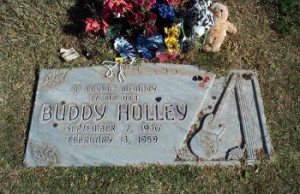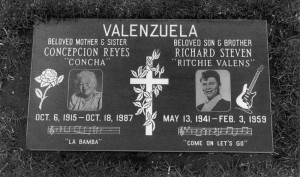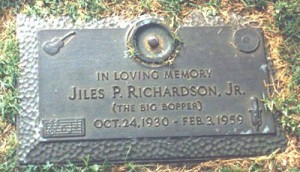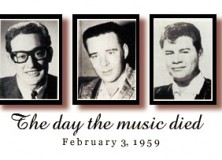 The Day the Music Died, so dubbed by a lyric in the Don McLean song “American Pie,” is a reference to the deaths of rock and roll musicians Buddy Holly, Ritchie Valens, and J. P. “The Big Bopper” Richardson, in a plane crash near Clear Lake, Iowa, on February 3, 1959. Pilot Roger Peterson was also killed.
The Day the Music Died, so dubbed by a lyric in the Don McLean song “American Pie,” is a reference to the deaths of rock and roll musicians Buddy Holly, Ritchie Valens, and J. P. “The Big Bopper” Richardson, in a plane crash near Clear Lake, Iowa, on February 3, 1959. Pilot Roger Peterson was also killed.
Every generation has their music idols. These three were among the top of the 1950’s generation. Those who grew up in the fifties mourned the premature deaths of their music idols. Memorials and remembrances occurred for years. Today, there are many websites memorializing their deaths, and detailing the events before and after the tragedy.
After terminating his partnership with The Crickets, Buddy Holly assembled a new band consisting of Waylon Jennings, Tommy Allsup, and Carl Bunch, to play on the ‘”Winter Dance Party” tour. The tour also featured rising artist Ritchie Valens and The Big Bopper, who were promoting their own recordings as well. The tour was to cover 24 Midwestern cities in three weeks.
 The distance between venues and the conditions prevalent aboard the poorly equipped tour buses adversely affected the performers. Cases of flu spread among the band members, and Holly’s drummer was hospitalized due to frostbite. Frustrated by the conditions, Holly decided to charter a plane when they stopped for their performance in the Surf Ballroom in Clear Lake, Iowa, to reach their next venue in Moorhead, Minnesota.
The distance between venues and the conditions prevalent aboard the poorly equipped tour buses adversely affected the performers. Cases of flu spread among the band members, and Holly’s drummer was hospitalized due to frostbite. Frustrated by the conditions, Holly decided to charter a plane when they stopped for their performance in the Surf Ballroom in Clear Lake, Iowa, to reach their next venue in Moorhead, Minnesota.
Carroll Anderson, owner of the Surf Ballroom, chartered the plane from the Dwyer Flying Service. Richardson, who was affected by the flu, swapped places with Waylon Jennings, taking the latter’s place on the plane, while Tommy Allsup lost his place to Ritchie Valens on a coin toss. Dion DiMucci (of Dion and the Belmonts fame) decided not to board the plane for the $36 fee.
The investigation of the incident determined that soon after take off, a combination of poor weather conditions and pilot error caused spatial disorientation that made pilot Roger Peterson lose control of the plane. Hubert Dwyer, owner of the flight service company, could not establish radio contact and reported the aircraft missing the next morning. He took off in his own Cessna 180 and spotted the wreckage less than six miles (9.7 km) northwest of the airport in a cornfield. He notified the authorities who dispatched Deputy Bill McGill, who drove to the wreck site and found the bodies of the passengers and pilot.
 Peterson, working on his instrument rating at the time, was still taking flight instrumentation tests and was not yet certified for flight into weather that required flying solely by instruments rather than by his own vision.
Peterson, working on his instrument rating at the time, was still taking flight instrumentation tests and was not yet certified for flight into weather that required flying solely by instruments rather than by his own vision.
The final Civil Aeronautics Board report noted that Peterson had taken his instrument training on airplanes equipped with an artificial horizon attitude indicator and not the far-less-common Sperry Attitude Gyro the Bonanza plane was equipped with. Peterson had also failed his instrument checkride shortly before the incident. Critically, the two instruments display aircraft pitch attitude but depict such information in a visual manner opposite of one another; therefore, the board considered that this could have caused Peterson to think he was ascending when he was, in fact, descending. They also concluded that Peterson did not receive adequate warnings about weather conditions that, given his known limitations, might have caused him to postpone the flight out of prudence.
Rumors v. Facts
Rumor: One persisted for years that Buddy Holly had possibly killed the pilot with a handgun, due to Holly’s gun being found two weeks after the crash, near where the plane came to rest.
Fact: The detailed and graphic autopsy performed the day after the crash – which has ultimately become available online – has put those rumors to rest. It confirms that the pilot had been killed by the crash and there is no evidence of a gun wound anywhere on the body of pilot Peterson.
Rumor: Since 1959 it had been speculated that J.P. “The Big Bopper” Richardson survived the initial impact of the crash and tried to go for help. Skeptics of the official conclusion that all the victims died on impact have noted that Richardson’s body was the only one found a significant distance from the wreckage — about 40 feet.
Rumor: As was the belief involving the pilot, the Bopper had suffered a gunshot wound.
Fact: In 2007, the Bopper’s son asked Dr. Bill Bass, founder of the University of Tennessee Anthropological Research Facility, to investigate the rumors by exhuming the Bopper’s body. Bass concluded by examining x-rays of the body that there was no evidence of gunshot wounds and that the Bopper’s massive injuries made it impossible for him to have moved, let alone survive beyond the moment of impact.
Disclaimer: On January 4, 2016, the owner of WestEastonPA.com began serving on the West Easton Council following an election. Postings and all content found on this website are the opinions of Matthew A. Dees and may not necessarily represent the opinion of the governing body for The Borough of West Easton.







